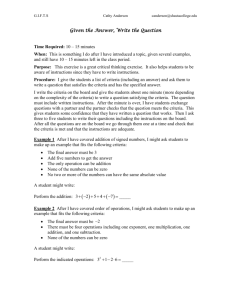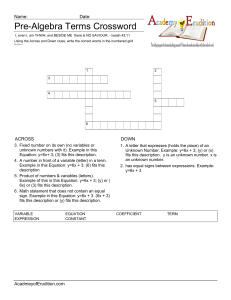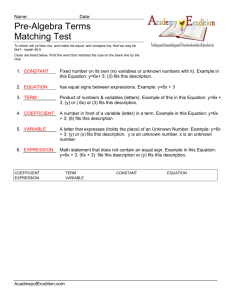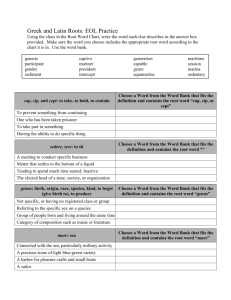SDO EVE Science Data Processing Workshop Don Woodraska December, 2009
advertisement
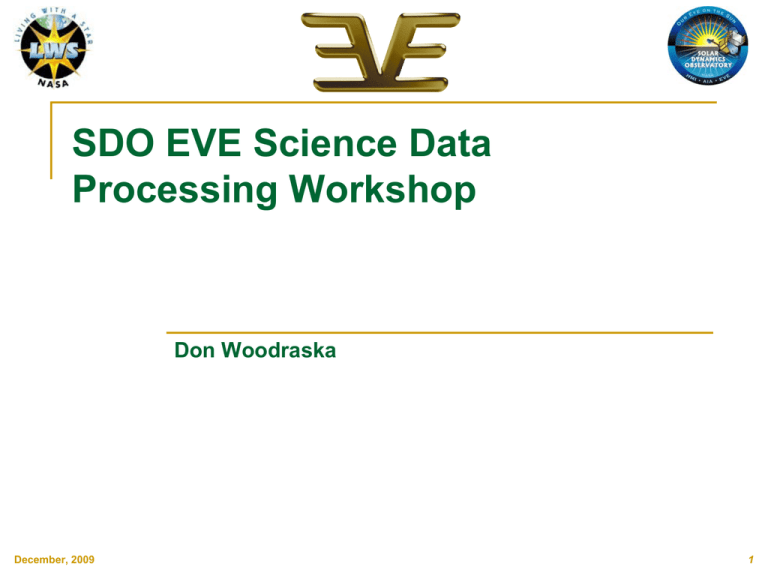
SDO EVE Science Data Processing Workshop Don Woodraska December, 2009 1 Agenda Introduction/Overview – Resource projections (Don Woodraska) Processing Overview – Product content Interfaces – DDS, IOC Level 0 Products – 0B, 0CS (Chris Jeppesen), 0C, 0D BREAK Level 1 Products MEGS-A, B Products (Don Woodraska) MEGS-A, B Calibration (Rachel Hock) MEGS-P (Tom Woods) ESP (Leonid) Additional Calibration Discussion (All) BREAK Level 2 – Spectrum & Lines/Bands(Chris Jeppesen) Level 3 (Chris Jeppesen) Special products – Mission merged Level 3, low-res, others (Don Woodraska) Data Dissemination Discussion (Don Woodraska) December, 2009 EVE Science Processing Workshop, Woodraska 2 Resource projections – Phase E (post-launch) Budget Year 1 Year 2 $x – addition/replacement of compute nodes $x – additional disk storage (+$3k maintenance) $x – off-site data storage $x – additional tapes $x – addition/replacement of compute nodes $x – additional disk storage $x – off-site data storage $x – replace adam001, adam002, & adam003 $x – additional tapes $x - Maintenance (beyond purchase for cluster2, disk, tape library) Year 3 December, 2009 $x – off-site data storage $x – replace/upgrade eve backup computer $x – replace cluster #1 (and FC raid1) and maintenance $x – upgrade tape library drives to newer technology $x – additional tapes EVE Science Processing Workshop, Woodraska 3 Resource projections – Year 1 needs Compute capacity Sufficient capacity exists for the first year, new nodes are not yet needed Additional disk Need 27 TB additional storage each year – 135 TB total for 5 year mission Technical Would like to purchase 60 TB+ using funds for nodes 10-ports of 16-port FC switch are in use, new disk would use 2 more Requires a new rack Additional tapes December, 2009 100 more tapes would be about $x Purchase spare replacement disks to reduce down-time EVE Science Processing Workshop, Woodraska 4 Processing Levels Level Description Span Type 0A (TLM) Unprocessed VCDUs (packets) – files received from DDS ~1 min binary 0B Assembled/merged integration separated by channel ~1 min FITS 0C Space weather (Ka-band) – all channels available in Latest and Daily files 15 min & 1 day ASCII 0CS Space weather (S-band) – lowest latency, only diodes and proxies Same ASCII 0D Daily merged 0B data with duplicates removed 1 day FITS 1 Fully calibrated science results for each channel (irradiance) 1 hour FITS 1A SAM only, event list 1 day FITS 1B SAM only, spectrum (cadence is TBD) Same FITS 2S Merged MEGS-A and B level 1 spectra to MEGS-B grid (.02 nm) 1 hour FITS 2L Extracted lines and bands, averaged diodes to match spectrum timestamp, proxies (same as 0C) Same FITS 3 Daily average spectrum at 0.02 nm 1 day FITS 3 Daily average 0.1 nm spectrum 1 year 3 Daily average 1 nm spectrum Mission FITS/N etCDF/ SAV December, 2009 5 Science Product Subsystem Overview Legend Code DDS Ka-band TLM data to SPOC Level 0A Level 0A to 0C are “time-critical” space weather data flow Levels 1-3 are not near-RT Test Patterns Public Products Primary are 0C, 0CS, 2, & 3 Level 0A, 0B, 0D complete Level 0C Most of 0CS, 1, 2, & 3 complete VCDU files Level 0A Data Reprocessing Level 0B IOC ENG Level 0B Level 1 Level 0D Level 0D Level 0C Level 2 RT Photo. Level 0CS Data Dissemination Subsystem Level 2 Level 3 December, 2009 SAM only S-band TLM data from IOC Level 1 Cal data FOV & Cruciforms, Flatfields, Darks, Higher Orders, etc Level 3 6 Science Product Availability Post-commissioning validation period ~ 6 months Analysis of in-flight calibrations Track relative changes between channels Suborbital rocket flight ESP, MEGS-A/B overlap, similar emission behavior Provides absolute calibration Post-flight NIST-SURF recalibration Normal product generation – publishing products to the web site S-band latency is seconds Photometer file combining ESP & MEGS-P Ka-band latency is > 3 minutes and < 15 minutes December, 2009 Level 0C is expected to be available after ~ 6 minutes Routine products available after 14 UT for the previous day. A single 4 Hz sample every 10-seconds for all photometer bands Completed ASDP packets available Best products available after 30 day routine reprocessing 7 Internal Data Access & Organization Primary access server Login tox NFS mounts are possible for desktops x will be retired Over 5 years old 2 primary disk volumes /x All processed data (no TLM) /xx Sensitive information has been removed December, 2009 EVE Science Processing Workshop, Woodraska 8 EVE-SOC Interface Overview SDO in Geosynchronous Orbit MOC at GSFC DDS at WSC near-RT science data files (Ka-band) RT HK (S-band) Handshake files Retransmitted science data files RT HK (S-band) Commands Daily HK file Planning data Retransmissions EVE SOC at LASP SPOC ENG Data IOC RT HK WWW December, 2009 USC 9 Interfaces DDS – DS3 (45 Mbps) WAN Ka-band science data - directed to interface computer x1 (x2) ~3-minute lag for real-time full science data Retransmission of science data 50 MB files pushed to EVE cluster for processing S-band housekeeping data - directed to x (engineering) ~1 second latency for health and safety x connects to evedp via TCP socket (0CS) One 4 Hz diode sample per 10 seconds from the slow packet IOC Pushes new ASDP and ENG data files to evefs1 prior to 1400 UT One FITS file per day (3 HDUs, binary tables) December, 2009 Location: …/data/eng/YYYY HDU #1: ASDP table HDU #2: Eng data from side A (TAI, Bus voltage, dec_htr_current) HDU #3: Eng data from side B 10 Orientation The SDO orientation is shown in the figure (464-ACS-ICD-0067 rev F) Solar North Reference (SNR) +x is S/C to sun direction +z along solar north pole +y completes the right-hand system ESP X = SNR Pitch angle EXP Y = SNR Negative Yaw angle SNR is rotated wrt SURF frame Axis same, names differ SURF z is along the beam SURF x is left-right SNR minus y SURF y is up-down SNR minus x SNR minus z EVE is usually rotated +/- 45 degrees in the SURF tank December, 2009 Rotation is about SURF z or SNR x which is a roll EVE Science Processing Workshop, Woodraska 11 Data Processing Timing and Version Numbering Space weather (S and Ka) Routine processing Seconds latency and < 15 minutes At 14 UT, the previous days routine processing begins (Level 1-3) Completed L0 data files from the MOC unavailable until this time. Routine reprocessing After 30 days, processing is repeated Holes are filled, we have all the data we will ever get Calibration/degradation corrections can be interpolated, higher quality products New Version release reprocessing When significant changes are made to the calibration corrections, or processing algorithms that impact the quality of the data, a new processing version number is created. Requires regenerating the entire mission Version Plan is subject to change December, 2009 The majority of compute time is spent doing this. Version 1 is the pre-flight, testing version Version 2 will be released on launch day Version 3 is expected after the first rocket calibration is applied (L+4 months) Version 4 is expected after the 2nd or 3rd rocket calibration is applied (L+12 months) Other versions… 12 Science Data Discovery Two complimentary databases LISIRD for daily averages (contains multiple missions, tools) EVE Custom: 1-minute data with links to data product files Daily insertion of calibrated data, NOT space weather Database can support search capability for finding files based on: Support automated external queries Database and appropriate tools can provide interactive browse capability Event discovery, time scaling (pan / zoom) Flares, anything else? Tables contain selected bands/lines, all 1-min avg. Time range, possibly flare flags, quality flags Need community input on what is desired Bands: ESP, MEGS-P bands, MA1, MA2, SAM, MB bands, bg estimates, AIA bands, GOES-R/13 bands, QEUV, SEM 304 band Lines Integrated over fixed range, includes background Are movies of spectra useful? December, 2009 13 Data File Details All data products are either ASCII or FITS Reader software ASCII files are readable by any text reader Some may have very long lines, where each line pertains to one date/time FITS standard readers FV (FITS View) is a graphical tool for opening/editing FITS files IDL software packages are available from several sources (like SolarSoft) EVE processing uses high-level mrdfits.pro/mwrfits.pro available from the GSFC IDL Astronomy Library (we also use the low-level cfitsio library) No convention for nested structures, so all internal structures are only 1 level or “flat” Level 1-3 files are all FITS Files contain an empty primary HDU (for compatibility), and a binary table A row in the table corresponds to a time Columns are data fields (scalars or arrays, no pointers, no objects, no structures) Each row pertains to one date/time December, 2009 Any requests for header keywords? Rather than treating metadata (like time, date, resolver, etc) as ASCII strings that need to be extracted from the header, it is included with the data and treated like data Limitations of FITS http://idlastro.gsfc.nasa.gov/fitsio.html Header keywords are sparsely used http://heasarc.gsfc.nasa.gov/ftools/fv/ Fixed length? 8639-8641 variable number of integrations depending on clock drift, power cycles, Ka-comm switches, etc. 14 Summary EVE SPOC contains sufficient hardware redundancy to produce products under most common failure scenarios EVE science processing will create files with several latencies File formats are ASCII and FITS Many standard readers exist for FITS, we use mrdfits.pro and fv Level 2 maintains the instrument spectral resolution Availability ranges from seconds to 30+ days Time cadence is maintained for CCD data Online accessible database (2) December, 2009 One for daily average data (LISIRD) One for 1-minute samples of bands and lines 15 Extracted Lines Wavelength (nm) Log T Ion Wavelength (nm) Log T Ion 9.39 6.81 Fe XVIII 46.52 5.71 Ne VII 13.12 5.57 Fe VIII 49.94 6.29 Si XII 13.29 6.97-7.16 Fe XX Fe XXIII 52.58 4.92 O III 17.11 5.81 Fe IX 55.44 5.19 O IV 17.72 5.99 Fe X 58.43 4.16 He I 18.04 6.07 Fe XI 59.96 4.92 O III 19.51 6.13 Fe XII 62.49 6.05 Mg X 20.20 6.19 Fe XIII 62.97 5.37 OV 21.13 6.27 Fe XIV 71.85 4.48 O II 25.63 4.75 He II 77.04 5.81 Ne VIII 28.42 6.30 Fe XV 79.02 5.19 O IV 30.38 4.70 He II 97.25 3.84 HI 33.54 6.43 Fe XVI 97.70 4.84 C III 36.08 6.43 Fe XVI 102.57 3.84 HI 36.81 5.99 Mg IX 103.19 5.47 O VI December, 2009 Fe series: VIII-XVI, XVIII, XX O series: II-VI 16
